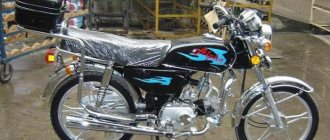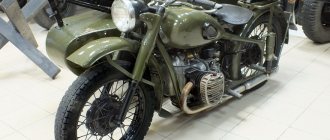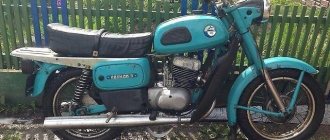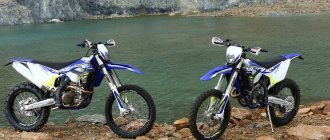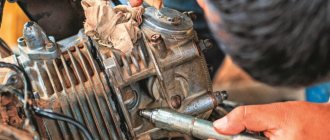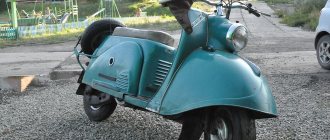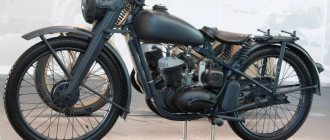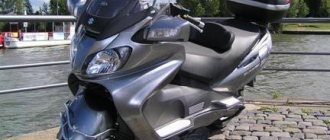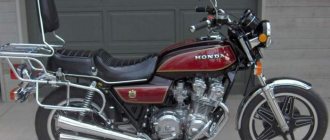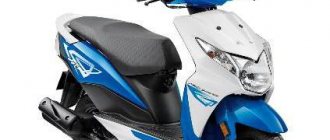Opposites BMW in motorcycle design
The two-cylinder boxer engine, or popularly simply “boxer”, is ingrained into the pages of the history of Bavarian motorcycle manufacturers so that it can no longer be cut out.
And despite BMW's increasing focus on inline engines, the boxer remains an icon for the Germans and periodically pops up in concepts and developments aimed at the future. BMW R1200R Special Edition at EICMA 2009
The question of whether there is a place for a boxer engine in the future of BMW is still relevant. And here it is very important to look at the current developments, concepts and projects that surround this internal combustion engine design.
One of the most sensational concepts on the “boxer” was, of course, the Lo Rider, shown at EICMA 2008. Of course, no one expected such a radical design from the naturally conservative BMW engineers. The bike offered a borderline blend of cruiser style, borrowing some elements from scramblers like the Derbi Mulhacen 659, and even taking something from street fighters a la streetfighters.
The main feature of the BMW Lo Rider is the ability to customize the appearance depending on the wishes of the owner. The list of changeable elements includes: an exhaust system that can be raised higher or lower, a two- or single-seat saddle, several types of headlights, a fuel tank with or without aluminum inserts.
Perhaps BMW engineers sculpted this project with an eye on the previous concept of two students from the International School of Design (France) Nicolas Bubar and Yves Dufeutrelle (22), who considered that the concept of “sportbike + boxer engine” required development. They were based on the same 1200 boxer and they also offered the ability to flexibly customize the motorcycle to the owner. The motorcycle, named IMME after the bankrupt German motorcycle manufacturer and the legendary R100 IMME 1948 model, was built in prototype form and presented on the BMW stand at the 2006 Intermot Motorcycle Show.
The tuning of the BMW 1150GS, named by its creator Klaus Beutler very simply: Beutler Boxer, looks more realistic. Yes, this is “just” tuning, but what a tuning!
The world premiere of the R 32 at the Berlin Motor Show aroused great interest. Until the end of the First World War, the Bavarian Motor Works (BMW) built only engines for airplanes, trucks and boats. In 1920, the first boxer engine was created and used by many German motorcycle manufacturers. With the creation of the R 32, BMW managed to enter the circle of companies producing vehicles even before the start of automobile production (1928). At the same time, the history of BMW boxer engines begins, which continues to this day for more than 75 years. With a working volume of 494 cm? and a power of 8.5 hp, the R 32, weighing only 120 kg, reached a speed of more than 90 km/h. Not least thanks to its low center of gravity, it always obeyed the driver well. The combination of ease of maintenance and high reliability quickly brought him good fame. Until 1926, more than three thousand R 32s were sold, each of which cost 2,200 imperial marks - more than competing models.
There is no way to miss the radical The Harrier from the Swede Stellan Egeland in this review. The boxer custom was deservedly awarded second place at the pan-European customization championship European Championship Of Bike Building 2009.
Menacing futuristic boxer street fighters, this is original, but where else could such an engine be installed? For example, in a futuristic supermoto that develops the ideas contained in the BMW HP2 Megamoto.
From all this we can conclude that the boxer engine remains an integral attribute of many design solutions, and therefore it is too early to write it off. And, despite the appearance of the sensational S1000RR series and the 6-cylinder Concept 6 from BMW, we, for our part, continue to expect the development of the good old, well-worn boxers.
Source
Douglas and BMW: the first signs
The first manufacturer of motorcycles with a boxer engine was Douglas from Bristol, England. Around 1905, its engineers developed the first two-cylinder engine with a 180-degree camber and a displacement of 200 cm³. Later, motorcycle engines with a displacement from 350 cm³ to 1 liter were created. All of them were distinguished by a “square” piston stroke (the cylinder diameter is equal to the stroke length) and a longitudinal arrangement of the cylinders. Also a signature feature of Douglas bikes was the belt drive to the wheel.
Around 1920, the design of Douglas engines was analyzed and revised by engineers at the young BMW company from Bavaria. The result of this work was the first boxer engine, the M2B15. This engine was used in the prototype Helios motorcycle of 1920. The bike's engine also had a longitudinal orientation of the cylinders, but the drive to the wheel was realized by a chain, not a belt.
The advantage of the longitudinal arrangement of the engine (with a transverse crankshaft) was the absence of the need to use helical gears. The transmission consisted of easier-to-manufacture straight-toothed gears, chains, shafts, pulleys, and belts. But the powerful boxer engine with longitudinal cylinders turns out to be very long and difficult to fit under the frame. In addition, the crankcase blocked the flow of oncoming air to the rear cylinder, causing it to overheat. Therefore, the appearance of engines designed for transverse installation (cylinders on the sides) became quite logical.
The first motorcycle with a transverse engine was the 1923 BMW R32. It was equipped with a half-liter M2B15 engine with a power of 8.5 hp. s., accelerating the bike to 95 km/h. For transverse installation, the engine was modified; a clutch and 3-speed transmission unit located at the rear was connected to the crankcase of its engine. For the first time on a boxer motorcycle, a wet sump with gearbox lubrication was used. Another innovative solution for motorcycles was the drive to the wheel using a cardan shaft.
It is the BMW R32 that can be considered the prototype of a modern motorcycle with a boxer engine. In further history, the only fundamental innovations in the design that can be distinguished are the suspension on shock absorbers. The R32 did not have them: the rear wheel was rigidly mounted, simple springs under the saddles were responsible for the comfort of the driver and passenger, and the front fork was equipped with a quarter-elliptical spring. Probably, at speeds close to maximum, the shaking on such a bike was quite noticeable, but for its days the BMW R32 was a very advanced motorcycle.
MY MOTORCYCLE
I wonder if everyone knows that the blue and white emblem that adorns the beautiful BMW cars and motorcycles symbolizes the propeller of an aircraft engine. Yes, exactly him - why?
Very popular after the war "BMW-R25/3", 1953-1956, 1 cylinder, ohv, 245 cm/cube, 13 l. s, 150 kg, 108 km/h. In 1959, BMW barely survived the crisis caused by both the general decline in demand for motorcycles and, to a greater extent, the lack of demand for its cars. BMW entered the automobile business back in 1929, acquiring a company located in Eisenach. But after the war, Eisenach found itself in the Eastern Zone of Occupation, and in 1951, automobile production was established in Munich, the hometown of BMW. By 1959, two types of cars were produced there: small “cuttlefish” with motorcycle engines and impressive sedans, whose design went back to pre-war models. The public no longer wanted either one or the other. The golden mean was found by the new management of the company only in 1961, when production of the excellent small car BMW-1500 began (its engine became the model for our M-412). But unfortunately, with all the attention paid to the production of cars, motorcycles were somehow overlooked. Not only was there no major update, but between 1960 and 1969 not a single new model was released at all!
On the one hand, it seemed that there was nothing wrong with this: BMW motorcycles were in small but steady demand, primarily among those who put dynamics and exceptional reliability in the first place - it’s not for nothing that among BMW buyers were police officers from many countries around the world (often they also serve Moscow patrols). But, on the other hand, in the 60s the idea of what a motorcycle should be changed so much (thanks to the efforts of primarily Japanese companies) that the desire to remain at the level once achieved smacked of suicide. BMW, fortunately, realized this in time, and in 1969 introduced the world to completely new motorcycles with a blue and white circle on the gas tank. While retaining traditional features - an opposed two-cylinder overhead valve engine, rear-wheel drive via a propeller shaft, as well as reliability and comfort - they were at the same time designed virtually from scratch. A new chassis with a front telescopic fork, electric engine start, and in addition, these motorcycles - for the first time in the history of the company - could no longer be used with a sidecar without serious modifications, which was fully in line with modern trends. Since that time, the company has been trying to keep pace with progress in motorcycle design. 1973 - disc brakes, five-speed gearbox.
The first production motorcycle with a large touring fairing was the BMW-R 100RS, from 1976, 2 cylinders, ohv. 980 cm/cube, 70 l. s, 230 kg, 200 km/h.
1976 - cast wheels, the world's first production motorcycle with a huge fairing that completely protects the driver from oncoming air flow. (“BMW-R 100RS”).
Touring enduro "BMW-R80GS", 1980-1987, 2 cylinders, ohv, 798 cm/cc, 50 hp, 167 kg, 170 km/h.
1980 - enduro style model "BMB-R80GS" with cantilever rear wheel suspension. It would seem that such a heavy motorcycle would not be particularly popular among fans of off-road driving. But it was appreciated by travel lovers, and soon it became the most popular model in the company's production program. On the basis of this motorcycle, special cars were created for the Paris-Dakar rally, which took first place four times. But the real revolution took place in 1983. Rumors that BMW was preparing something new to replace its boxer car had been circulating long before this moment. The company willingly played along with these rumors, demonstrating at exhibitions either a turbocharged motorcycle or a V-shaped “six”.
From Bristol to the Urals
Having appeared in England at the beginning of the 20th century, by the end of the 30s motorcycles with boxer engines were gaining popularity and reached the USSR from Germany. In 1938, the Nazi government ordered a new heavy motorcycle with sidecar from BMW for the Wehrmacht. This motorcycle was the BMW R71, which replaced the R12 and R17. The lower valve engine of this bike had a power of 22 hp, and the gearbox was 4-speed. For the first time, the frame received a spark plug type rear suspension with shock absorbers. The BMW R71 has proven itself well; in particular, the cardan drive turned out to be much more reliable than the chain drive in mud and sand conditions.
At the end of the 30s, the leadership of the Red Army was faced with the question of a new motorcycle for the needs of the armed forces. After all, the domestic PMZ A-750 was outdated, and its reliability can be judged by the popular decoding of the abbreviation PMZ as “try to turn me on.” It was decided to adopt experience from the Germans, and the BMW R71 was chosen as a role model, as the most modern of military bikes. In 1939, the Soviet government secretly bought 5 motorcycles from Sweden and handed them over to the engineers of the Moscow Motorcycle Plant (MMZ).
In the USSR, the design of the BMW R71 was slightly revised, adapting it to the realities of domestic technologies. The result of this work was the M-72 motorcycle, produced since 1941. Before the war, MMZ was engaged in its assembly, and when the Germans approached the capital in 1942, the factory equipment was evacuated to Irbit.
The M-72 was produced until 1960, and in the 50s it was simultaneously produced in the Urals and Kiev. A total of 8,500 vehicles were produced; until the mid-50s, all of them were used for the needs of the army, and later they were occasionally sold to the public.
In the post-war years, IMZ did not develop the design of the lower-valve opposed M-72; the next transitional model was the M-61. It combined the M-72 frame with a new 650 cm³ overhead valve boxer engine. Later, the model was replaced by the new heavy motorcycle "Ural" M-62. But in Kyiv, at KMZ, the successors of the motorcycle in the form of the K-750 and Dnepr were produced until the 90s.
Contract engines for BMW motorcycles: what are they?
Motorcycles are rightfully in great demand all over the world. Today, the company specializes in the production of progressive motorcycle equipment and produces modern models of motorcycles of all classes - from touring to cross-country. Each model has its own differences. For example, cruiser motorcycles and sports bikes are equipped with the most powerful engines with a volume of 1700, 1400 and 1000 cm3. Cross bikes, in comparison, have rather modest characteristics. offers a large selection of high-quality contract BMW engines. The advantage of Japanese contract engines is that they are used in different road conditions: on smoother and even roads. Moreover, engines in Japan have low mileage and they simply do not have time to fail, maintaining good performance.
From Bristol to the Urals: the early history of boxer motorcycles in Europe
Among motorists, a boxer engine is usually associated with Subaru; retro lovers remember the VW Kafer, but among motorcyclists, a “boxer” (as such engines are called in America) is a sign of a powerful and heavy bike.
The inventor of the boxer engine is the legendary Karl Benz, who patented an engine with a 180-degree cylinder camber in 1896. Due to their low height, symmetrical design, balanced inertial forces and relative simplicity, such motors became widespread in the then nascent aviation. The cylinders located on the sides of the nose of the airplane were perfectly blown by the propeller and oncoming flows. This made it possible to eliminate the cooling system from the design, making the engine lighter.
The first boxer motorcycles were created in Bristol (England), where they began their “journey to the east.” Later, Germany became the center of production of such bikes, and by World War II, the opposition reached the USSR. Now let’s dive into the history of a century ago and try to quickly walk this path together.
MY MOTORCYCLE
The BMW concern has not been producing lower valve engines for very long: two decades. But it was this engine - in its most advanced version, the R71 - that became the basis for millions of Ural and Kyiv motorcycles. So for us he is the most important opponent...
1918, the year of Germany's defeat in World War I, almost became fatal for BMW. The terms of surrender provided for the vanquished party to completely abandon the production of both aircraft and aircraft engines. By decree of the demobilization commissioner on December 6, the plant was closed, and an order was received to prepare for the dismantling of the equipment. To maintain production, it was urgently necessary to master the production of civilian products. The salvation was a license for the manufacture of railway braking systems from the Berlin company Knorr-Bremse AG. Business went well - so much so that the Berliners completely bought out BMW. It would seem that this is where the brand sank into oblivion. But its former main shareholder, Austrian entrepreneur Camillo Castiglioni, felt that the restrictions imposed by the winners were weakening and it would soon be possible to resume production of aircraft engines. And in 1922, he bought from Knorr-Bremse the rights to the BMW brand and part of the production - exactly the one where they made aluminum castings and assembled engines.
The 1920 Victoria KR1 motorcycle used a boxer engine manufactured by BMW.
Until orders for aviation products are found, something more mundane can be produced. By that time, the company was already producing a two-cylinder boxer engine designed by Martin Stroller with a power of 6.5 hp. — it was used both as a stationary one and on Helios and Victoria motorcycles. The engine on these cars was installed like on the popular (and many times copied) British Douglas: one cylinder forward, the other back, the crankshaft across, which greatly facilitated the use of a belt or chain drive on the rear wheel. Castiglioni owned another half-dead aviation company - Bayerische Flugzeugwerke AG (BFW), the same one that produced Helios. When he decided to merge both companies together, BMW CEO Franz Josef Popp and chief designer Max Fritz were tasked with mastering the production of the motorcycle at their own facilities. After a short inspection, Fritz gave a disappointing verdict: the best thing to do with Helios is to drown it in a pond. And he immediately received a new order: if so, then he gets complete freedom in designing the first BMW motorcycle.
Weaknesses and shortcomings of the IMZ-8.103-10 engine
It has become popular, at the same time, and expensive to have a high-quality and powerful motorcycle from well-known global suppliers. But our Ural motorcycle is not far from foreign motorcycles; if you look at the prices, you’ll go crazy, the price is like a car. Therefore, new Urals are rarely bought on the domestic market, although they are supplied to the Armed Forces of the Russian Federation and other law enforcement agencies, but abroad they are in, albeit small, but definite demand. Most of the motorcycles available to the population are outdated models produced in the last century; prices in those days were affordable. Speaking about the Ural motorcycle, the first thing that comes to mind is what kind of IMZ-8.103-10 (IMZ-8.103-30, M-67-36) engine it has, are there any shortcomings and weak points, because it is the qualities and characteristics of the engine that underlie the characteristics motorcycle Ural.
Characteristics of engines of modifications of Ural motorcycles
Source
